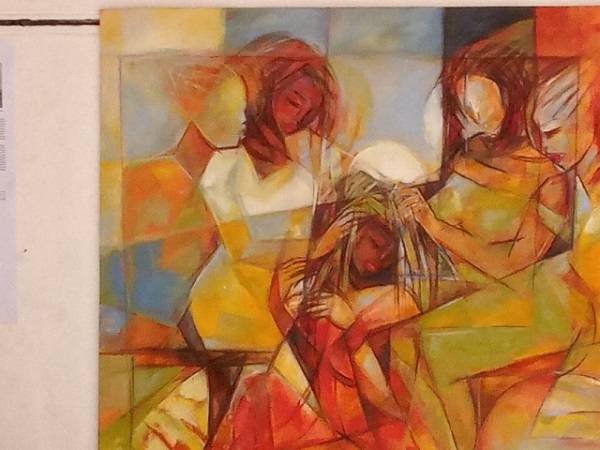
Studio practice remains an integral tool for art academics to disseminate art knowledge and skills to their students, and therefore need not be shunned.
ART | DOMINIC MUWANGUZI | Art is a practical subject that calls for art production. This definition, however doesn’t exclude art academicians whose practice largely entails teaching and researching; culminating into the production of theoretical material used by art learners at university. Art scholars too need to produce art as part of their research processes. Prof. Francis Musango Gwatamu during his tenure at the school of Fine Art, Makerere did emphasize this school of thought. Thus, he often dictated that his students produce art as part of their research. Previously, Mrs. Trowel the founder of the Makerere art school, a teacher to Musango, had emphasized the same. She would ask her students to be independent thinkers and creators; qualities that were realized through studio practice (Margaret Trowel And The Development of Art Education in East Africa, by Elsbeth Joyce Smith). Suffice to say, her mentees like Gregory Maloba, who later became a tutor at the school, produced remarkable works like the Uganda Independence Monument (1962), Ham Mukasa’s bust (Undated) at the Uganda Museum and The Hunter (Undated).
The substitution of studio practice for publication in a practical discipline like art can be problematic. Here, the idea of creative practice involving originality and community relevance is undercut. Naturally, art production should serve as a tool to communicate a visual message to the audience like is the case with Independence Monument that conveys the message of Uganda’s liberation from colonial rule. In light of this artwork, the public is fully engaged by the underlying message carried in the Statue. This is critical for the artist because he has achieved connection with the community. In reality, artists do not live and work in isolation of their surroundings. Such impact is hardly felt in an article published in a literary journal- the school of Industrial of Fine art (MTSIFA) has an academic structure of appreciation of both studio practice and literary publication for post graduate students. However, with a balance of the two practices, there is an emerging trend among lecturers to dwell more on writing academic material that only relate to a section of the public.
The Different But One Exhibition, organized by Rebecca Uziel is annual showcase of lecturers studio work at the school of Industrial and Fine Art, Makerere. The inspiration for this enduring artistic venture is to compel art teachers at the school, to engage in studio practice, among other reasons. On certain occasions, some scholars have exhibited specific projects they’re working on leading to their post graduate postings. On other times, such researched material has been absent. Understandably, lecturers get too busy to find time to open their studios as they juggle between teaching, student supervision and research, but the primary demand to produce art should not be compromised or substituted in the event of executing these academic functions. But the perennial dismal participation in this multi-disciplinary exhibition, alongside the showcase of old works of art, replicated for this show, points to the growing trend to sideline studio practice by art lecturers at the school. Such practice is a sign to the lack of innovation arising from not regularly engaging in studio practice.
Though art exhibitions, like Different But One, do not necessarily reflect the active participation in studio practice by lecturers, they at least provide inspiration to art scholars to routinely create art. This practice keeps them in touch with their immediate surroundings as reflected in Nabulime’s solo exhibition Dreams and Consequences, Dr. Lilian Nabulime, 2018. In this seminal exhibition, Nabulime a senior lecturer in the department of Sculpture, presented figurines navigating the subject of behavioural norms and practices of young people on university campus. The inspiration for this studio production was based on her ardent observations of behaviour patterns of young girls- mostly her students- on campus. This close up study, leading to the production of sculptures suggestive of emotions, perceptions and feelings of young females, qualifies her to the heights of master artist. Nabulime was invited to be among the eight tutors for the fourth edition of Kampala Art Biennale (KAB20). Her art has also appeared in leading art journals and magazines on the continent.
This studio practice undertaken by Dr. Nabulime is a perfect example of how important art is in creating meaningful relationships and sustainable conversations in the community. This particular exhibition premised itself on the awareness and prevention of HIV/ Aids among young people on university campuses. The magnitude of the impact created with this body of work, is incomparable based on the academic, cultural and social significance the artworks stimulated. It may be difficult to elicit such holistic response if it were a piece of literature on the same topic, published in a local or international journal. Not to down play the importance of published material, for it is equally important in inspiring debate on topical subjects, it is however critical to emphasize the notion of art production for art lecturers because of its communal relevance; regardless of social status, education and cultural background.
Studio practice should be the norm for art teachers at university and the tradition of striking a balance between art production and publication for subsequent academic promotion should be maintained. An attempt to overturn this tradition will bring into question the type of art graduates produced by the art institutions. If lecturers cannot create art, can they really produce artists who can sufficiently compete in the fast- developing art world?
*****
This essay was written as a response to the ongoing trend of art academics at higher institutions of learning shunning studio work in preference to publishing literary works.
 The Independent Uganda: You get the Truth we Pay the Price
The Independent Uganda: You get the Truth we Pay the Price



